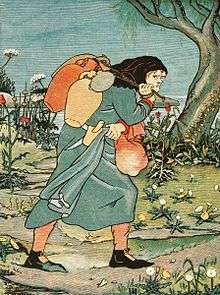Mary Eliza Haweis

Mary Eliza Haweis, née Joy (21 February 1848, in London – 24 November 1898, in Bath, Somerset), was an English author of books and essays, particularly for women, a scholar of Chaucer, illustrator and painter. She was the daughter of the painter Thomas Musgrave Joy, wife of the Rev. Hugh Reginald Haweis and mother of painter Stephen Haweis.[1]
Biography
Aged 18, she exhibited a painting at the Royal Academy under her maiden name Miss M. E. Joy in 1866, the year her father died.[1] The following year, on 30 November 1867, she married Hugh Reginald Haweis. With his Pet; or, Pastimes and penalties (1874) she began illustrating her husband's books.
Combining a widespread interest in art, fashion, history, and literature, and to supplement the household income, she was soon writing herself. Usually giving her name as Mrs. H. R. Haweis, she first wrote Chaucer for Children (1877) which she also illustrated herself. Very preoccupied with style, several books on decoration, dress, and household matters followed. The first The Art of Beauty (1878) was based on and amplified articles she had written some years earlier for the "Saint Pauls Magazine". This was followed by The Art of Dress (1879), The Art of Decoration (1881), and The Art of Housekeeping (1889). From 1880 she wrote essays on artistic houses, first published in the magazine The Queen, later collected in a book.
Together with her husband, Mary Haweis successfully campaigned to have museums opened on Sundays. Shortly before her death, she finished the novel A Flame of Fire (1897) which reflects her feminist views.
Chaucer

In her work as a Chaucerian, she popularized a number of Chaucer's stories from The Canterbury Tales and some of the shorter poems in anthologies designed for children and for adult non-scholarly readers. She not only provided modernized translations and Pre-Raphaelite illustrations of key scenes from the tales, but also included the type of critical apparatus otherwise only available in the contemporary scholarly editions published by Frederick James Furnivall, Walter W. Skeat, and Richard Morris. Her adaptations played a role in widening general access to Chaucer's poetry and in promoting the reading of Middle English verse in its original.[2]
References
- 1 2 Connolly, Margaret (2004). "Haweis, Mary Eliza". Oxford Dictionary of National Biography (online ed.). Oxford University Press. doi:10.1093/ref:odnb/33764. (Subscription or UK public library membership required.)
- ↑ Margaret Connolly, 'Dr Furnival and Mother like the same old books': Mary Haweis and the Experience of Reading Chaucer in the Nineteenth Century, in: Eminent Chaucerians? Early Women Scholars and the History of Reading Chaucer, ed. Richard Utz and Peter Schneck, Philologie im Netz (Supplement 4, 2009), pp. 5-20.
Further reading
| Wikimedia Commons has media related to Mary Eliza Haweis. |
- Bea Howe, Arbiter of Elegance, London, Harvill Press, 1967 (Biography of Haweis).
- Judith Flanders, Inside the Victorian Home: a Portrait of Domestic Life in Victorian England. New York: W. W. Norton, 2004.
- Mary Flowers Braswell, The Chaucer Scholarship of Mary Eliza Haweis (1852–98), in: Chaucer Review 39 (2005), 402–419.
- Oscar Wilde, John Cooper, Oscar Wilde On Dress: CSM Press (2013).
External links
- Works by Mary Eliza Joy Haweis at Project Gutenberg
- Works by or about Mary Eliza Joy Haweis at Internet Archive